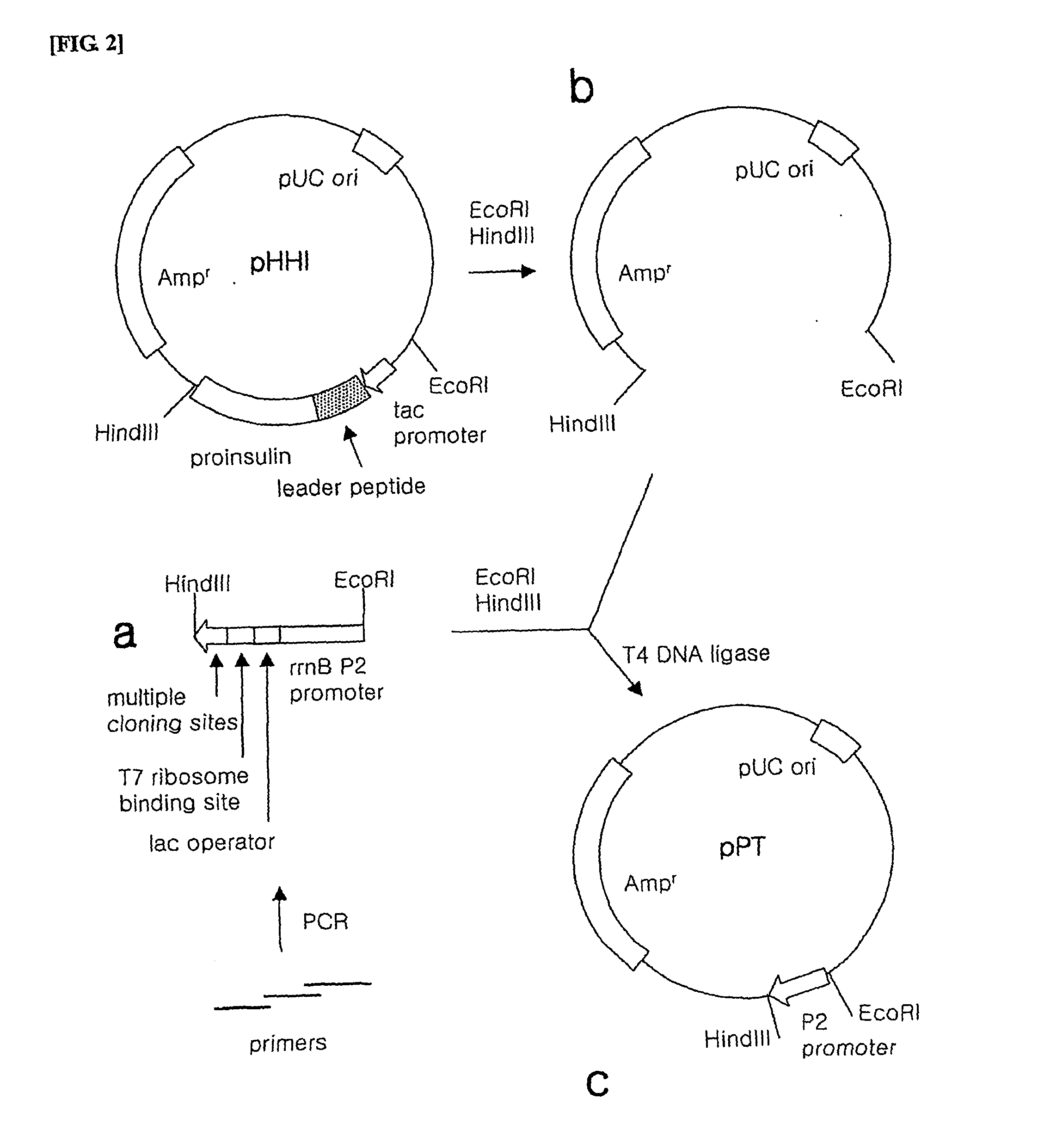Plasmids expressing human insulin and the preparation method for human insuling thereby
a technology of human insulin and plasmids, which is applied in the field of human insulin expression plasmids and the preparation of human insulin, can solve the problems of requiring considerable industrial production costs, low yield of proinsulin fusion protein, and short half life of proteins in host cells, and achieves the effect of easy isolation from the target protein
- Summary
- Abstract
- Description
- Claims
- Application Information
AI Technical Summary
Benefits of technology
Problems solved by technology
Method used
Image
Examples
example 1
Preparation of Inventive pK-BKpi Type and pK-BRpi Type Plasmids
[0101] The pK-BKpi type and pK-BRpi type plasmids were prepared as follows.
[0102] 1) Preparation of Proinsulin Fusion Protein Gene
[0103] In order to prepare the proinsulin fusion protein gene to be inserted into the expression vector, PCR was performed using pHHI, the expression plasmid of the proinsulin fusion protein as a template.
[0104] Here, a forward primer among the used primers was synthesized to include a NdeI restriction enzyme recognition site, a sequence encoding the leader peptides of SEQ ID NO. 1, 2, 3, 5, 6 or 7 and a sequence encoding the N-terminal fragment of insulin B-chain in order (the leader peptide of SEQ ID NO. 1: SEQ ID NO. 17, the leader peptide of SEQ ID NO. 2: SEQ ID NO. 18, the leader peptide of SEQ ID NO. 3: SEQ ID NO. 19, the leader peptide of SEQ ID NO. 5: SEQ ID NO. 20, the leader peptide of SEQ ID NO. 6: SEQ ID NO. 21, the leader peptide of SEQ ID NO. 7: SEQ ID NO. 22), while a revers...
example 2
Preparation of Inventive pPT-BKpi Type and pPT-BRpi Type Plasmids
[0111] The pPT-BKpi type and pPT-BRpi type plasmids according to the present invention were prepared as follows.
[0112] 1) Preparation of Promoter
[0113] In order to prepare a P2 promoter, a lac operator, a T7 ribosome binding site and restriction enzyme cleavage sites to be inserted into the vector, PCR was performed using tree primers including a part of the sequence.
[0114] The first primer was synthesized to have an EcoRI restriction enzyme recognition site and the upstream of P2 promoter in the forward direction (SEQ ID NO. 24), the second primer was synthesized to have −35 region, −10 region of P2 promoter and lac operator sequentially in the reverse direction (SEQ ID NO. 25) and the third primer was synthesized to have a T7 ribosome binding site and NdeI, KpnI, XhoI, SalI, HindIII restriction enzyme cleavage sites sequentially in the reverse direction (SEQ ID NO. 26).
[0115] Since the 3′-end of the first primer...
example 3
Preparation of Inventive pPT-17Kpi and pPT-17Rpi Plasmids
[0125] The pPT-17Kpi and pPT-17Rpi plasmids were prepared as follows.
[0126] 1) Preparation of Proinsulin Fusion Protein Gene
[0127] In order to prepare the proinsulin fusion protein gene to be inserted into the expression vector, PCR was performed using pHHI, the expression plasmid of the proinsulin fusion protein as a template.
[0128] Here, a forward primer among the used primers was synthesized to include a NdeI restriction enzyme recognition site, a sequence encoding the leader peptides of SEQ ID NO. 4 or 8 and a sequence encoding the N-terminal fragment of insulin B-chain in order (the leader peptide of SEQ ID NO. 4: SEQ ID NO. 27, the leader peptide of SEQ ID NO. 8: SEQ ID NO. 28), while a reverse primer was synthesized to include a XhoI restriction enzyme recognition site. (SEQ ID NO. 23). The sequences of the respective primers are as follows.
5′- GAA ACA CAT ATG ACC ATG ATT ACGSEQ ID NO. 27GAT TCA CTG GCA GTC GTT TT...
PUM
| Property | Measurement | Unit |
|---|---|---|
| Fraction | aaaaa | aaaaa |
| Time | aaaaa | aaaaa |
| Angle | aaaaa | aaaaa |
Abstract
Description
Claims
Application Information
 Login to View More
Login to View More - R&D
- Intellectual Property
- Life Sciences
- Materials
- Tech Scout
- Unparalleled Data Quality
- Higher Quality Content
- 60% Fewer Hallucinations
Browse by: Latest US Patents, China's latest patents, Technical Efficacy Thesaurus, Application Domain, Technology Topic, Popular Technical Reports.
© 2025 PatSnap. All rights reserved.Legal|Privacy policy|Modern Slavery Act Transparency Statement|Sitemap|About US| Contact US: help@patsnap.com



